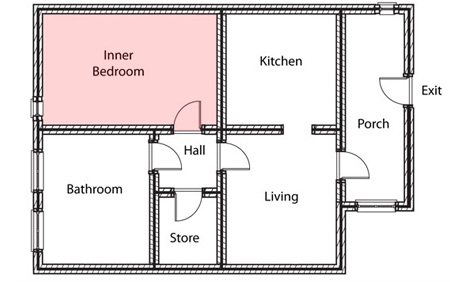
The Problem
An Inner Room is simply a room reached through another living area, known as an Access Room or Outer Room. They threaten life because a fire in the access room can seriously impede escape from the property. Inner bedrooms are particularly dangerous, as an occupant may be deep asleep and perhaps even under the influence of alcohol when a fire starts in the outer room.
In this situation, a closed bedroom door is a mixed blessing – although it may hold back smoke for a time, it also reduces the sound level of any alarm sounding in the outer room. Slow to awaken, the sleeper may awaken to discover a significant fire and thick smoke on the exit route.

Two examples of inner room which must be addressed:
- When construction work changes the layout of your property, you need to pass through the Building Control process and comply with current Building Regulations.
- Where you are a landlord or otherwise involved in letting a property with inner rooms with no second escape route, even if your property complied with Building Regulations when the building was built.
What does Guidance say about inner rooms and AWFSS?
Your Building Control Officer will likely have a policy on this matter, so consult them before installing fire suppression as a 'compensatory measure'. Automist can protect inner rooms. Consideration from a fire engineer is required to determine whether retrofittable fire suppression is suitable for a specific application. The LACoRS guide states:
… provision of a suitable water suppression system can, in some circumstances, allow for relaxed provision of certain other fire safety measures [such as] relaxed requirements for inner rooms.
Learn more - Can the risk of inner rooms in small paying-guest accommodations be reduced with Automist?
Reviewed: 01/01/2019. Our articles are reviewed regularly. However, any changes made to standards or legislation following the review date will not have been considered. Please note that we provide abridged, easy-to-understand guidance. To make detailed decisions about your fire safety provisions, you might require further advice or need to consult the full standards and legislation.
